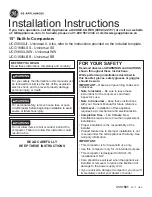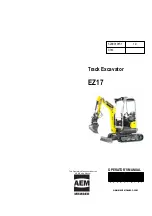
CHAPTER 2 - SAFETY, DECALS, AND HAND SIGNALS
2-6
Issued 01-08 Bur
87722071 NA
OPERATING PRECAUTIONS
•
Check brakes, steering and other machine control
devices in accordance with the manufacturer’s
instructions prior to starting operation. Observe all
gauges or warning instruments for proper
operation. Operate all controls to insure proper
operation. If any malfunctions are found, remove
the starter key or disconnect switch key. Place a
DO NOT OPERATE tag on the machine until the
malfunction is corrected.
•
If a failure that causes loss of control such as
steering, service brakes or engine occurs, stop
the machine motion as quickly as possible,
remove the starter key or disconnect switch key.
Place a DO NOT OPERATE tag on the machine
and keep it securely parked until the malfunction
is corrected or the machine can be safely towed.
•
Understand the machine limitations and keep the
machine under control.
•
Operate and drive the machine with care and at
speed compatible with conditions. Use extra
caution when operating over rough ground, on
slopes, and when turning.
•
Note and avoid all hazards and obstructions such
as ditches, underground lines, trees, cliffs,
overhead electrical wires or areas where there is
danger of a slide.
•
Carry loads in recommended positions for
maximum stability.
•
Never lift loads in excess of capacity.
•
Use the recommended machine ballast and
counterweighting.
•
Know and understand the job site traffic flow
patterns and obey signalmen, road signs and
flagmen.
•
Know and understand that job site conditions may
change on an hourly basis. Hills of dirt, debris or
obstructions may grow and change from the time
you began the day. It is your responsibility to
monitor the changes and keep the machine, tools
and attachments, etc. a safe distance.
•
Watch for bystanders and never allow anyone to
be under or to reach through the machine and its
equipment while operating.
•
Select a gear that will prevent excessive speed
when going downhill. Do not coast downhill.
•
When roading a machine, know and use the
signaling devices required on the machine.
Provide an escort for roading where required.
•
On machines with independently operated wheel
brakes, lock the brake pedals together when
roading to provide equalized brake application.
•
Use the recommended transport devices when
roading the machine.
•
Use the approved drawbar and / or attachment
point when using the machine for towing. If a
cable or chain is used, keep people away from the
tow line.
•
Before you operate at night, check that all lamps
illuminate.
•
If your machine has a cab make sure that all
windows are clean and that the windshield wipers
and washers work correctly.
•
Engine exhaust fumes can cause death. If you
operate this machine in an enclosed area, make
sure there is ventilation to replace the exhaust
fumes with fresh air.
•
Check all controls in a clear area and make sure
the machine is operating correctly.
•
Dust, fog, smoke, etc., can decrease your vision
and cause an accident. Stop the machine or
decrease the speed until you can see.
•
Contact with high voltage power lines,
underground cables, etc., can cause serious
injury or death from electrocution.
•
Before you drive or operate in an area with high
voltage lines, cables, or a power station, tell the
power or utility company what you are going to do.
You MUST HAVE THE POWER DISCONNECTED
OR KEEP A SAFE WORKING DISTANCE from the
lines, cables, or power station. Keep all parts of
the machine a safe distance away from the power
source. You must also know any federal,
state/provincial, or local safety codes or
regulations that apply to the job site.
•
If a part of the machine touches high voltage
power:
1. Warn other workers NOT TO TOUCH THE
MACHINE and to stay away from the machine.
2. If you can break contact, reverse the operation
that caused contact with the high voltage power,
and move the machine away from the danger
area. If you cannot break contact stay in the
machine until the utility company de-energizes
the line and tells you that the power is off.
•
If you have extreme conditions, such as a fire,
etc., and you are forced to leave the machine, do
not step off the machine. Jump as far from the
machine as possible with your feet together and
do not touch the ground with your hands.






































